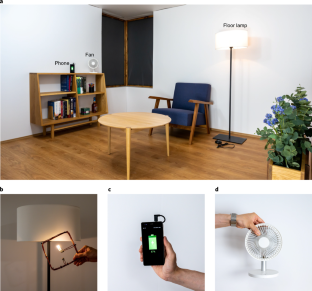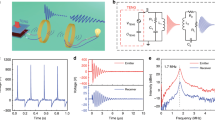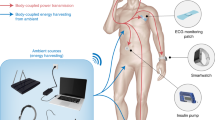Abstract
Magnetoquasistatic wireless power transfer can be used to charge and power electronic devices such as smartphones and small home appliances. However, existing coil-based transmitters, which are composed of wire conductors, have a limited range. Here we show that multimode quasistatic cavity resonance can provide room-scale wireless power transfer. The approach uses multidirectional, widely distributed currents on conductive surfaces that are placed around the target volume. It generates multiple, mutually unique, three-dimensional magnetic field patterns, where each pattern is attributed to different eigenmodes of a single room-scale resonator. Using these modes together, a power delivery efficiency exceeding 37.1% can be achieved throughout a 3 m × 3 m × 2 m test room. With this approach, power exceeding 50 W could potentially be delivered to mobile receivers in accordance with safety guidelines.
This is a preview of subscription content, access via your institution
Access options
Access Nature and 54 other Nature Portfolio journals
Get Nature+, our best-value online-access subscription
$29.99 / 30 days
cancel any time
Subscribe to this journal
Receive 12 digital issues and online access to articles
$119.00 per year
only $9.92 per issue
Buy this article
- Purchase on Springer Link
- Instant access to full article PDF
Prices may be subject to local taxes which are calculated during checkout





Similar content being viewed by others
Data availability
The data that support the findings of this study are available from the corresponding author upon reasonable request.
References
Da Xu, L., He, W. & Li, S. Internet of Things in industries: a survey. IEEE Trans. Ind. Informat. 10, 2233–2243 (2014).
Weiser, M. The computer for the 21st century. SIGMOBILE Mob. Comput. Commun. Rev. 3, 3–11 (1999).
Kamalinejad, P. et al. Wireless energy harvesting for the Internet of Things. IEEE Commun. Mag. 53, 102–108 (2015).
Brown, W. C. The history of power transmission by radio waves. IEEE Trans. Microw. Theory Techn. 32, 1230–1242 (1984).
Shinohara, N. Power without wires. IEEE Microw. Mag. 12, S64–S73 (2011).
Strassner, B. & Chang, K. Microwave power transmission: historical milestones and system components. Proc. IEEE 101, 1379–1396 (2013).
Garnica, J., Chinga, R. A. & Lin, J. Wireless power transmission: from far field to near field. Proc. IEEE 101, 1321–1331 (2013).
International Commission on Non-Ionizing Radiation Protection. Guidelines for limiting exposure to time-varying electric, magnetic, and electromagnetic fields (up to 300 GHz). Health Phys. 74, 494–522 (1998).
Sample, A. P., Meyer, D. A. & Smith, J. R. Analysis, experimental results, and range adaptation of magnetically coupled resonators for wireless power transfer. IEEE Trans. Ind. Electron. 58, 544–554 (2011).
Ricketts, D. S., Chabalko, M. J. & Hillenius, A. Experimental demonstration of the equivalence of inductive and strongly coupled magnetic resonance wireless power transfer. Appl. Phys. Lett. 102, 053904 (2013).
Assawaworrarit, S., Yu, X. & Fan, S. Robust wireless power transfer using a nonlinear parity–time-symmetric circuit. Nature 546, 387–390 (2017).
Assawaworrarit, S. & Fan, S. Robust and efficient wireless power transfer using a switch-mode implementation of a nonlinear parity–time symmetric circuit. Nat. Electron. 3, 273–279 (2020).
Kurs, A. et al. Wireless power transfer via strongly coupled magnetic resonances. Science 317, 83–86 (2007).
Zhou, J., Zhang, B., Xiao, W., Qiu, D. & Chen, Y. Nonlinear parity-time-symmetric model for constant efficiency wireless power transfer: application to a drone-in-flight wireless charging platform. IEEE Trans. Ind. Electron. 66, 4097–4107 (2019).
Kurs, A., Moffatt, R. & Soljačić, M. Simultaneous mid-range power transfer to multiple devices. Appl. Phys. Lett. 96, 1–4 (2010).
Hui, S. Y. R., Zhong, W. & Lee, C. K. A critical review of recent progress in mid-range wireless power transfer. IEEE Trans. Power Electron. 29, 4500–4511 (2014).
Uno, Y. et al. Luciola: a millimeter-scale light-emitting particle moving in mid-air based on acoustic levitation and wireless powering. Proc. ACM Interact. Mob. Wearable Ubiquitous Technol. 1, 166 (2018).
Sample, A. P., Waters, B. H., Wisdom, S. T. & Smith, J. R. Enabling seamless wireless power delivery in dynamic environments. Proc. IEEE 101, 1343–1358 (2013).
Chabalko, M. J., Shahmohammadi, M. & Sample, A. P. Quasistatic cavity resonance for ubiquitous wireless power transfer. PLoS ONE 12, 1–14 (2017).
Sasatani, T., Yang, C. J., Chabalko, M. J., Kawahara, Y. & Sample, A. P. Room-wide wireless charging and load-modulation communication via quasistatic cavity resonance. Proc. ACM Interact. Mob. Wearable Ubiquitous Technol. 2, 188 (2018).
Chabalko, M. J. & Sample, A. P. Resonant cavity mode enabled wireless power transfer. Appl. Phys. Lett. 105, 243902 (2014).
Chabalko, M. J. & Sample, A. P. Three-dimensional charging via multimode resonant cavity enabled wireless power transfer. IEEE Trans. Power Electron. 30, 6163–6173 (2015).
Sasatani, T., Chabalko, M. J., Kawahara, Y. & Sample, A. P. Multimode quasistatic cavity resonators for wireless power transfer. IEEE Antennas Wireless Propag. Lett. 16, 2746–2749 (2017).
Kajfez, D. & Hwan, E. J. Q-factor measurement with network analyzer. IEEE Trans. Microw. Theory Techn. 32, 660–670 (1984).
Haus, H. A. & Huang, W. Coupled-mode theory. Proc. IEEE 79, 1505–1518 (1991).
Zargham, M. & Gulak, P. G. Maximum achievable efficiency in near-field coupled power-transfer systems. IEEE Trans. Biomed. Circuits Syst. 6, 228–245 (2012).
Christ, A., Douglas, M., Nadakuduti, J. & Kuster, N. Assessing human exposure to electromagnetic fields from wireless power transmission systems. Proc. IEEE 101, 1482–1493 (2013).
Sunohara, T., Hirata, A., Laakso, I., De Santis, V. & Onishi, T. Evaluation of nonuniform field exposures with coupling factors. Phys. Med. Biol. 60, 8129–8140 (2015).
Chen, X. L. et al. Human exposure to close-range resonant wireless power transfer systems as a function of design parameters. IEEE Trans. Electromagn. Compat. 56, 1027–1034 (2014).
Institute of Electrical and Electronics Engineers. IEEE Standards Coordinating Committee 28. IEEE Recommended Practice for Measurements and Computations of Radio Frequency Electromagnetic Fields With Respect to Human Exposure to Such Fields, 100 kHz–300 GHz (IEEE, 2002).
Christ, A. et al. Evaluation of wireless resonant power transfer systems with human electromagnetic exposure limits. IEEE Trans. Electromagn. Compat. 55, 265–274 (2013).
Lin, D., Zhang, C. & Hui, S. Y. R. Mathematic analysis of omnidirectional wireless power transfer—Part-II three-dimensional systems. IEEE Trans. Power Electron. 32, 613–624 (2017).
Choi, B. H., Lee, E. S., Sohn, Y. H., Jang, G. C. & Rim, C. T. Six degrees of freedom mobile inductive power transfer by crossed dipole Tx and Rx coils. IEEE Trans. Power Electron. 31, 3252–3272 (2016).
Acknowledgements
This work was supported by a Grant-in-Aid for JSPS Fellows JP18J22537, JST ERATO grant number JPMJER1501 and JST ACT-X grant number JPMJAX190F. We thank M. J. Chabalko for discussions. We also thank K. Narumi, H. Ogata and T. Ikeuchi for help in the video production.
Author information
Authors and Affiliations
Contributions
T.S., Y.K. and A.P.S. designed the research. T.S. proposed the initial concept, conceived the theory, implemented the system, performed the experiments/analysis and wrote the manuscript. All the authors reviewed and commented on the manuscript. Y.K. and A.P.S. provided the resources. Y.K. supervised the project.
Corresponding author
Ethics declarations
Competing interests
The authors declare no competing interests.
Additional information
Peer review information Nature Electronics thanks Jenshan Lin and the other, anonymous, reviewer(s) for their contribution to the peer review of this work.
Publisher’s note Springer Nature remains neutral with regard to jurisdictional claims in published maps and institutional affiliations.
Supplementary information
Supplementary Information
Supplementary Figs. 1–11, Table 1 and Notes 1 and 2.
Supplementary Video 1
Overview of the room-scale resonator, including the resonator structure, mounted lumped capacitors, covered range and an animation of the oscillating current/magnetic field.
Supplementary Video 2
Demonstration of room-scale wireless power transfer in a living environment.
Rights and permissions
About this article
Cite this article
Sasatani, T., Sample, A.P. & Kawahara, Y. Room-scale magnetoquasistatic wireless power transfer using a cavity-based multimode resonator. Nat Electron 4, 689–697 (2021). https://doi.org/10.1038/s41928-021-00636-3
Received:
Accepted:
Published:
Issue Date:
DOI: https://doi.org/10.1038/s41928-021-00636-3
This article is cited by
-
Intelligent wireless power transfer via a 2-bit compact reconfigurable transmissive-metasurface-based router
Nature Communications (2024)
-
Intelligent metasurfaces: control, communication and computing
eLight (2022)



